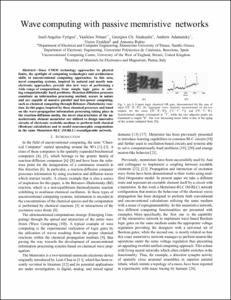Mostra el registre d'ítem simple
Wave computing with passive memristive networks
| dc.contributor.author | Fyrigos, Iosif |
| dc.contributor.author | Ntinas, Vasileios |
| dc.contributor.author | Sirakoulis, Georgios |
| dc.contributor.author | Adamatzky, Andrew |
| dc.contributor.author | Erokhin, Victor |
| dc.contributor.author | Rubio Sola, Jose Antonio |
| dc.contributor.other | Universitat Politècnica de Catalunya. Departament d'Enginyeria Electrònica |
| dc.date.accessioned | 2019-09-26T13:41:51Z |
| dc.date.available | 2019-09-26T13:41:51Z |
| dc.date.issued | 2019 |
| dc.identifier.citation | Fyrigos, I. [et al.]. Wave computing with passive memristive networks. A: IEEE International Symposium on Circuits and Systems. "2019 IEEE International Symposium on Circuits and Systems (ISCAS): proceedings: 26-29 May 2019: Sapporo, Japan". Institute of Electrical and Electronics Engineers (IEEE), 2019, p. 15-19. |
| dc.identifier.isbn | 978-1-7281-0398-3 |
| dc.identifier.uri | http://hdl.handle.net/2117/168771 |
| dc.description | © 2019 IEEE. Personal use of this material is permitted. Permission from IEEE must be obtained for all other uses, in any current or future media, including reprinting/republishing this material for advertising or promotional purposes,creating new collective works, for resale or redistribution to servers or lists, or reuse of any copyrighted component of this work in other works. |
| dc.description.abstract | Since CMOS technology approaches its physical limits, the spotlight of computing technologies and architectures shifts to unconventional computing approaches. In this area, novel computing systems, inspired by natural and mostly nonelectronic approaches, provide also new ways of performing a wide range of computations, from simple logic gates to solving computationally hard problems. Reaction-diffusion processes constitute an information processing method, occurs in nature and are capable of massive parallel and low-power computing, such as chemical computing through Belousov-Zhabotinsky reaction. In this paper, inspired by these chemical processes and based on the wave-propagation information processing taking place in the reaction-diffusion media, the novel characteristics of the nanoelectronic element memristor are utilized to design innovative circuits of electronic excitable medium to perform both classical (Boolean) calculations and to model neuromorphic computations in the same Memristor-RLC (M-RLC) reconfigurable network. |
| dc.format.extent | 5 p. |
| dc.language.iso | eng |
| dc.publisher | Institute of Electrical and Electronics Engineers (IEEE) |
| dc.subject | Àrees temàtiques de la UPC::Enginyeria electrònica::Microelectrònica::Circuits integrats |
| dc.subject.lcsh | Integrated circuits |
| dc.subject.lcsh | Logic circuits |
| dc.subject.other | Wave computing |
| dc.subject.other | Memristors |
| dc.title | Wave computing with passive memristive networks |
| dc.type | Conference report |
| dc.subject.lemac | Circuits integrats |
| dc.subject.lemac | Circuits lògics |
| dc.contributor.group | Universitat Politècnica de Catalunya. HIPICS - Grup de Circuits i Sistemes Integrats d'Altes Prestacions |
| dc.identifier.doi | 10.1109/ISCAS.2019.8702789 |
| dc.description.peerreviewed | Peer Reviewed |
| dc.relation.publisherversion | https://ieeexplore.ieee.org/document/8702789 |
| dc.rights.access | Open Access |
| local.identifier.drac | 25825602 |
| dc.description.version | Postprint (author's final draft) |
| local.citation.author | Fyrigos, I.; Ntinas, V.; Sirakoulis, G.; Adamatzky, A.; Erokhin, V.; Rubio, A. |
| local.citation.contributor | IEEE International Symposium on Circuits and Systems |
| local.citation.publicationName | 2019 IEEE International Symposium on Circuits and Systems (ISCAS): proceedings: 26-29 May 2019: Sapporo, Japan |
| local.citation.startingPage | 15 |
| local.citation.endingPage | 19 |


